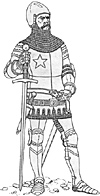
I have been wargaming actively for the past 4 years, although I am not sure that some of my fellow garners here in the Tri-Cities area would consider me 'active.' Sometimes I have to miss games due to family commitments. With two small daughters, aged 7 and 5, there are frequent demands on my time. My kids do seem to get a kick out of watching me paint the various models I have been collecting, but so far that is as far as their interest goes. I look forward to the day when my 7 year old says to me, "Daddy, can you show me how to play with your army?"
The bad thing is that there are a lot of games out there that take several hours to complete and the rules are pretty advanced. For a 7 year old they would probably be way too confusing, especially when she would need to add 1 for enfilade or subtract 2 if unit is worn. So how do I get her started down the path of wargaming, and make her mother squirm at the thought that there are now two wargamers in the house? I found a set of rules on a free games website, called Knights vs. Knights.
These are so simple to use that my daughter would have no trouble becoming proficient the very first time she plays. The original rules used a coin flip to determine a kill, but I kept thinking that we would probably spend most of the game on the floor picking up the coin or fixing the models that were knocked over by an errant toss, so I modified them to use a die. I also modified another couple of items, so that the game would flow a little easier.
Here are the rules:
At start of game, each player rolls 1 die. The one who rolls the higher number is the attacker. Attacker gets first turn and goes through the sequence of play as active player, then the Defender goes through the sequence of play as active player.
Sequence of Play
1) Move units
2) Resolve melee
3) Fire missiles.
Movement Mounted = 9" Foot = 6"
Move in any direction. No long winding maneuvers! May move out of melee, but not into another melee during the same turn.
Melee combat strength
Mounted with lance = 3
Mounted with other weapon = 2
Foot with spear/pike/pole = 2
Foot with other weapon = 1
Melee Combat Procedure
Compare active player combat strength to inactive player. Active player rolls dice based on the following. If result is:
- Equal to: roll 1 die Less than: roll 1 die
Greater than: roll 1, plus the combat strength difference. (e.g., active player has 2 combatants with combined combat strength of 4. Inactive player has 1 combatant with strength of 2. Roll 1 die plus difference 2 for a total of 3 dice.)
Resolving Combat
If result is a 5 or 6, they're dead!
Missile Fire
| Weapon | Firing Range | Dice to Roll |
|---|---|---|
| Crossbow | 0" - 4" | 2 |
| Crossbow | 4" - 7" | 3 |
| Bow | 0" - 4" | 2 |
| Bow | 4" - 9" | 3 |
| Longbow | 0" - 4" | 2 |
| Longbow | 4" - 12" | 3 |
If result is a 5 or 6, they're dead!
If the archer moved this turn, roll 1 less die. Archer cannot shoot into melee, divide shots between two or more enemy, or move out of melee and shoot during the same turn.
As the enemy gets closer, the archer gets more nervous and doesn't have the time to launch as many arrows. This is represented by rolling fewer dice.
The first time I played this with a friend, we each used 5 archers and 5 mounted knights from my Warhammer Bretonnian Army. We noticed that there were too many kills with the 50% chance so we modified the rules to 33%, which cut down on the shooting carnage and made the game last a bit longer. We used each model as an independent figure and fired each of the 5 archers separately. Once we made the modifications the game was pretty easy to follow and take about 20 minutes to complete. I think that keeping the game small and short will keep a young person interested and not give up because they are bored.
These rules can be modified to allow for pistols and rifles for those gamers who would like to use their British/ Zulu or US Civil War models.
If you know any young kids and would like to get them interested in the fun hobby of wargaming, give these rules a try. Have fun, and happy gaming!
Back to Citadel Spring 2003 Table of Contents
Back to Citadel List of Issues
Back to MagWeb Master Magazine List
© Copyright 2003 by Northwest Historical Miniature Gaming Society
This article appears in MagWeb (Magazine Web) on the Internet World Wide Web. Other articles from military history and related magazines are available at http://www.magweb.com